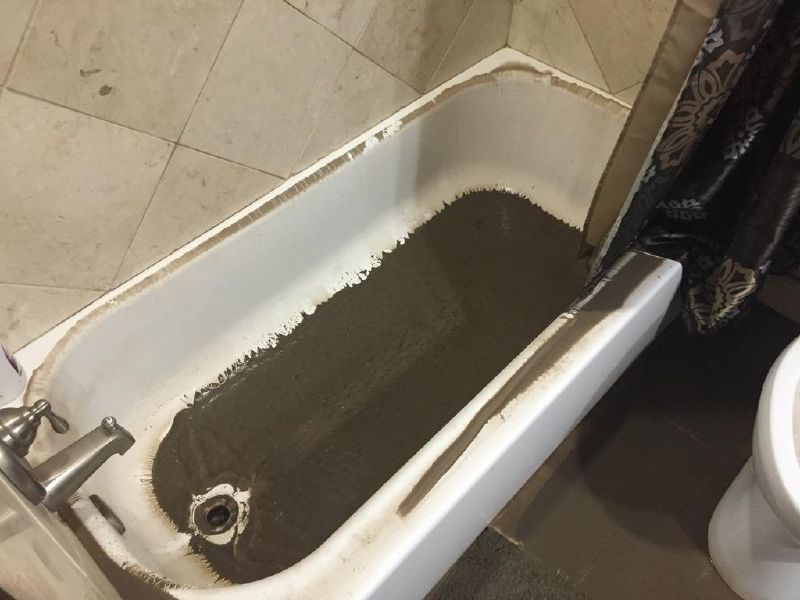Important Factors Behind Waste in the Bathtub
Important Factors Behind Waste in the Bathtub
Blog Article
We have stumbled upon this great article on What to Do if Sewage Starts Coming Up Through Your Bathtub down the page on the net and reckoned it made perfect sense to discuss it with you here.

Sewage backup in the tub can be a stressful and unhygienic trouble for any house owner. Not only is it inconvenient, yet it also postures serious health and wellness threats and suggests underlying issues with the plumbing system. Recognizing why sewage is turning up with the bath tub is crucial for taking suitable action to deal with the trouble effectively.
Introduction to the Problem
Usual Reasons for Sewer Backup
Obstructions in the Drain Line
Among one of the most typical reasons for sewer backup is a clog in the sewer line. This can occur as a result of the accumulation of particles, grease, or foreign things in the pipelines, avoiding correct circulation and causing sewage to back up right into your bathtub.
Tree Origin Breach
Tree origins seeking dampness and nutrients can penetrate sewer lines through small fractures or joints. In time, these roots can expand and expand, triggering significant damage to the pipelines and leading to sewage back-up concerns.
Understanding the Issue
When sewer starts backing up into the bathtub, it's a clear sign of an issue with the water drainage system. The wastewater that ought to be moving away from your home is rather discovering its way back right into your home, which can bring about substantial damage and carcinogen.
Prospective Causes
Several variables can add to sewage back-up in the bathtub. From clogs in the drain line to problems with the plumbing facilities, recognizing the origin is essential for finding a service.
Aging Framework
Older homes may have dated plumbing systems that are more susceptible to rust, cracks, and deterioration. As pipes age, they end up being extra prone to leakages and clogs, boosting the probability of sewage backup occurrences.
Heavy Rainfall or Flooding
During durations of heavy rainfall or flooding, the drain system might come to be overloaded with excess water, creating backups and overflows. This can cause sewer supporting into tubs and various other fixtures inside the home.
Indicators of Sewage Back-up
Foul Odors
Unpleasant smells originating from drains or components, particularly in the shower room, may show sewage backup concerns. These smells are often solid and persistent, signifying an issue that needs immediate attention.
Slow Draining Fixtures
Bath tubs, sinks, and commodes that drain gradually or not at all could be experiencing sewage back-up. If numerous fixtures are affected all at once, it's likely that the problem originates from a typical point, such as the major sewage system line.
Gurgling Sounds
Weird gurgling or gurgling noises originating from drains when water is running elsewhere in the house are a measure of air caught in the plumbing system. This air buildup can arise from sewer backup and need to be explored without delay.
Health And Wellness Threats Associated with Sewer Back-up
Contamination of Supply Of Water
Sewage back-up can pollute the water supply in your home, presenting a severe health threat to you and your household. Exposure to polluted water can cause intestinal problems, skin infections, and various other illnesses.
Mold and mildew Growth
Moisture from sewage back-up can produce perfect conditions for mold and mildew growth in your home. Mold spores can aggravate respiratory problems and create allergies in sensitive people, making punctual clean-up necessary.
Spread of Illness
Sewage contains unsafe bacteria, infections, and parasites that can create a range of conditions, consisting of hepatitis, cholera, and gastroenteritis. Coming into contact with sewage or contaminated surface areas puts you in jeopardy of infection.
Cleaning Up After Sewer Backup
Disinfection Procedures
Completely sanitize and sterilize impacted areas after sewer back-up to remove dangerous germs and prevent mold development. Usage proper cleansing products and protective equipment to make sure risk-free and efficient cleanup.
Reconstruction of Influenced Areas
Fix any type of damages to floor covering, walls, or components caused by sewage back-up. Relying on the extent of the damages, you may require to change carpets, drywall, or various other materials to restore your home to its pre-loss problem.
Immediate Actions to Take
Shutting Off Water
In case of sewage backup, it's essential to shut off the water system to stop additional contamination and damages. Situate the main water shutoff valve in your house and shut it off till the concern can be settled.
Speaking To a Professional Plumber
Handling sewage back-up is not a DIY work. Get in touch with an accredited plumber with experience in dealing with sewage-related concerns to examine the circumstance and execute needed repair services or clean-ups.
Staying Clear Of Contact with Contaminated Water
Up until the sewage back-up is settled, prevent contact with polluted water to stop the spread of microorganisms and pathogens. Wear safety equipment if you must be in the afflicted area and clean your hands completely later.
Preventive Measures
Regular Upkeep of Sewage System Lines
Schedule normal assessments and maintenance of your drain lines to recognize and attend to prospective issues before they escalate right into significant troubles. This can consist of cleaning particles, checking for tree root invasion, and fixing any broken pipelines.
Mounting Backwater Shutoffs
Take into consideration mounting backwater valves in your plumbing system to avoid sewer from flowing back right into your home throughout durations of heavy rainfall or flooding. These shutoffs automatically close when water draws back up, securing your residential property from contamination.
Correct Disposal of Home Waste
Prevent flushing anything apart from bathroom tissue and human waste down the bathroom to stop blockages and obstructions in the sewage system line. Dispose of oil, oil, and other family chemicals correctly to decrease the danger of plumbing problems.
Why Is Water Backing Up in My Bathtub When I Flush My Toilet?
What to do about a sewer line clog
First, don’t bother with plunging. No amount of plunging will dislodge the clog in a sewer line. The clog is too far away. Plungers are for clogs in the toilet itself, not the sewer line. Plus, the most likely causes of a sewer clog are:
Tree roots Flushed toys or feminine products Grease buildup Those items don’t move easily. And in the case of tree roots, the roots need to be cut out of the pipe and the pipe will need to be repaired.
You’ll need a closet auger. A closet auger is a type of plumber’s snake with a protective cover to keep from scratching the delicate porcelain toilet. If the clog is further down, you may need to remove the toilet or use one of your cleanouts to get to the clog.
We also recommend doing a video inspection of the drain to ensure that the cause of the clog has been completely removed. Otherwise, you could have the same problem again in a few days or weeks.
https://mspplumbingheatingair.com/blog/why-is-water-backing-up-in-my-bathtub-when-i-flush-my-toilet

Hopefully you enjoyed reading our article on What to Do if Sewage Starts Coming Up Through Your Bathtub. Thanks for taking the time to read through our content. In case you appreciated our blog posting if you please be sure to pass it around. Thanks a bunch for your time. Come back soon.
Call Today
Report this page